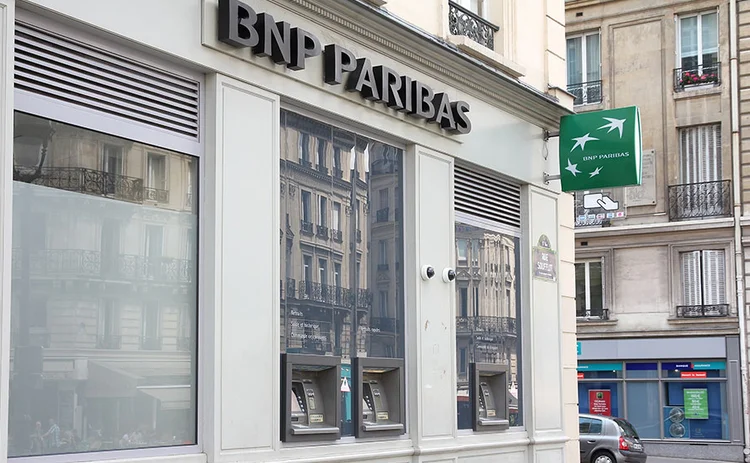
Credit portfolio manager of the year: BNP Paribas
Risk Awards 2024: Team handles huge increase in remit while adjusting CRT to Basel III

Every bank in Europe that uses internal models to calculate its capital requirements is watching nervously as the January 2025 implementation date for the third capital requirements regulation (CRR III) looms into view. Crucially, the new framework will include a floor that stops model outputs from falling below 72.5% of the capital requirements calculated using the regulator-set standardised approaches.
Since credit risk-weighted assets (RWAs) form the large majority of banks’ risk-based balance sheet, credit portfolio management (CPM) will be essential to maintain lending even if CRR III drives credit risk capital requirements higher. And this major regulatory change is occurring in an environment where interest rates have risen sharply over the past two years, fuelling concerns that default rates will begin to track higher as well.
We want to support the bank to continue financing our clients. We also want to make sure that we help the bank meeting its solvency criteria… and also we want to make sure that we bring value to our shareholders
Thomas Alamalhoda
This was the context for a decision in 2022 that has transformed the CPM function at BNP Paribas. The CPM team established programmes of significant risk transfer and credit insurance in 2016, specifically for the corporate and institutional bank (CIB). Pleased with the results, and with one eye fixed on the regulatory future, the board decided in 2022 to extend the team’s mandate to cover the whole bank – more than tripling the assets potentially in scope, from €150 billion to €500 billion. This is a pivotal step for the European lender in advancing towards its ambitious 2025 plan, which aims to effectively manage RWAs and capital to meet the required ratio before the implementation of CRR III.
“There are different entities, and some of them had been doing things, but in a very scattered manner,” says Thomas Alamalhoda, head of portfolio management solutions at BNP.
The “optimal scheme”, he explains, needs to provide consistent information to investors and secure approval from regulators, which means getting all the stakeholders around the same table to present “one single entity going into the market”.
“We want to support the bank to continue financing our clients. We also want to make sure that we help the bank meeting its solvency criteria,… and also we want to make sure that we bring value to our shareholders,” says Alamalhoda. “I would say we have three types of stakeholders… and I’m really grateful to be in this position to serve clients and shareholders and contribute to the financial stability of the bank.”
His team set about building relationships across the retail and small business banking entities of the group during 2022, covering activities from asset selection to pricing structure and data management. Quickly adapting to manage a threefold increase in assets is no easy task – it requires the CPM team to strategically plan and allocate resources.

Instead of reinventing the wheel and undertaking an aggressive hiring spree, the team has opted for a smarter and more measured approach by maximising the use of existing resources. Much of this work needs to be done by the local teams, rather than the CPM division itself.
“I won’t say we have three times more assets under management, and hence we need to triple the number of people in our team – that’s not realistic,” says Alamalhoda. “What we need is to create a network to empower local teams,” rather than trying to run everything from the centre.
He says the biggest gaps were in the culture of proactive capital management and reliable data practices, so the CPM team has undertaken substantial efforts to develop and maintain robust databases to ensure local processes collect and store as much information as possible at origination. Indicators such as probability of default and recovery rates are vital for pricing discussions with SRT investors.
“Once we’ve done that, we can then work with local teams and make sure the assets we originate meet the criteria for SRT and distribution programmes,” says Alamalhoda.
By the final quarter of 2022, the team was ready to start bringing transactions to market from outside the CIB. In the year to September 2023, the bank closed five cash and 10 synthetic credit risk transfers covering a portfolio of €39 billion, together with another €7 billion covered under 12 credit insurance deals. BNP Paribas’s CRT origination is expected to grow by more than 20% to record levels in 2023, together with a 16% growth in the size of the credit insurance portfolio.
Ready for the output floor
The advent of CRR III was one of the key drivers for expanding the scope of CPM, and therefore the team has also devised tools to simulate the impact of the new rules on RWAs for each type of credit product and integrate that into decision-making on SRT transactions.
“In this business, the way the cost of capital is computed on the underlying portfolio is key,” says Alamalhoda. “The economic risk of these assets has not changed, it’s the same asset and so the investor will ask for pretty much the same premium, but the regulatory capital consumption could change.”
In particular, the output floor means the bank must now evaluate credit risk capital consumption using not just the internal ratings based (IRB) approach, but also the standardised approach.
“This is challenging yet exciting for us, and we are prepared to meet all requirements,” says Alamalhoda.
In this business, the way the cost of capital is computed on the underlying portfolio is key
Thomas Alamalhoda
Notably, he foresees adverse impacts on vital real economy assets like transportation and project finance, because the standardised approach does not offer the same RWA relief as IRB on the use of risk mitigation structures such as collateral or guarantees.
“These assets play a key role in the low-carbon transition, for instance, and if the regulatory capital costs for their financing are too high, it could impede the transition,” says Alamalhoda. “Therefore, we need to find ways to continue financing these assets to support the real economy.”
For SRT, the major implication is that banks will need to transfer more risk on the same portfolio, which requires a thicker mezzanine tranche in each deal. If the price expected by existing funded investors is too great, the thicker tranche will become uneconomical for the originating bank, so diversifying the investor base is vital. BNP Paribas has significantly expanded the number of credit insurance counterparties, adding 20 insurers to their roster since 2017, all of which belong to insurance groups with a credit rating of A or higher.
“[SRT] has value for a lot of people, and sometimes the cash investors and unfunded investors can be complementary,” says Alamalhoda. “If you have a thicker mezzanine tranche, you could have cash investors on the lower mezzanine looking for more yield and a riskier portfolio, and on the upper mezzanine you can have credit insurers, which are fine with lower risk and lower premium that hits their [return] target.”
Unloaded revolvers
The expanded remit has brought with it a raft of first-time deals for BNP Paribas. These include a transaction with trade finance facilities as the underlying, and the bank’s debut deal with the World Bank’s private finance subsidiary, the International Finance Corporation. The December 2022 Meridian deal involved the IFC providing second-loss protection on a €1 billion portfolio of emerging market trade finance facilities.
“This was a space that was not covered by regular investors that we were dealing with before, and so we found a good match between what we had to propose, and what the IFC would like to see as per its mandate,” says Alamalhoda.
And the CPM team has not been neglecting its original relationship with the CIB either. The bank closed the Harewood deal, also in December 2022, which was its first SRT supporting the leveraged finance business. The trade referenced a portfolio of $950 million spread evenly across US and European borrowers. Unusually, it included undrawn overdraft and revolving credit facilities.
“We already do distribution of term loans to CLO [collateralised loan obligation] managers, but like many banks we had revolving credit facilities remaining on our book because this is not something that you can sell easily on the market, since it is not fully drawn and drawing rates vary over time,” says Alamalhoda.
As the borrowers are highly leveraged, these revolvers consume significant RWAs, and BNP Paribas had been keen to find a willing investor for some time. The Harewood deal was eventually sold to a single strategic SRT investor who had appropriate expertise, to provide a high degree of execution certainty. The trade was structured as a fully funded credit-linked note with a 16% mezzanine tranche.
“We have done it in a challenging economic environment in the second half of 2022, but there was very good momentum with the investor, we were all aligned and we had a very good quality portfolio, which makes things easier in terms of placement,” says Alamalhoda. “It was really a success and a hopeful sign for future deals.”
Only users who have a paid subscription or are part of a corporate subscription are able to print or copy content.
To access these options, along with all other subscription benefits, please contact info@risk.net or view our subscription options here: http://subscriptions.risk.net/subscribe
You are currently unable to print this content. Please contact info@risk.net to find out more.
You are currently unable to copy this content. Please contact info@risk.net to find out more.
Copyright Infopro Digital Limited. All rights reserved.
As outlined in our terms and conditions, https://www.infopro-digital.com/terms-and-conditions/subscriptions/ (point 2.4), printing is limited to a single copy.
If you would like to purchase additional rights please email info@risk.net
Copyright Infopro Digital Limited. All rights reserved.
You may share this content using our article tools. As outlined in our terms and conditions, https://www.infopro-digital.com/terms-and-conditions/subscriptions/ (clause 2.4), an Authorised User may only make one copy of the materials for their own personal use. You must also comply with the restrictions in clause 2.5.
If you would like to purchase additional rights please email info@risk.net
More on Awards
Trading systems: structured products/cross-asset – Murex
Murex won the Trading systems: structured products/cross-asset award at the 2025 Risk Markets Technology Awards for its MX.3 platform, praised for its flexibility and advanced analytics
Best vendor for system support and implementation: Murex
Murex has won the Best vendor for system support and implementation at the Risk Markets Technology Awards, recognised for its innovative MX.3 platform, exceptional client support and seamless implementation services
FRTB-IMA product of the year: Murex
Murex wins FRTB-IMA product of the year for its advanced, scalable MX.3 platform enabling seamless regulatory compliance
Pricing and analytics: equities – Finastra
Finastra’s Sophis platform wins the Risk Markets Technology Award for Pricing and analytics in equities, recognised for its robust capabilities in equities and derivatives trading
Best execution product of the year: Tradefeedr
Tradefeedr won Best execution product of the year for its API platform, which standardises and streamlines FX trading data, enabling better performance analysis and collaboration across financial institutions
Collateral management and optimisation product of the year: LSEG Post Trade
LSEG Post Trade wins Collateral management and optimisation product of the year for interconnected services that help mitigate counterparty risk and optimise capital usage
Clearing house of the year: LCH
Risk Awards 2025: LCH outshines rivals in its commitment to innovation and co-operation with clearing members
Driving innovation in risk management and technology
ActiveViam secured three major wins at the Risk Markets Technology Awards 2025 through its commitment to innovation in risk management and technology







